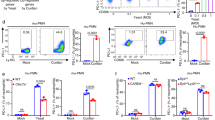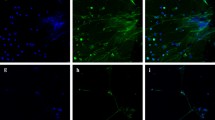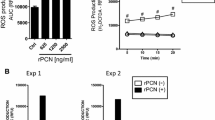Abstract
Caspase recruitment domain-containing protein 9 (CARD9) is an adaptor molecule that is critical for NF-κB activation and forms a complex with B cell lymphoma 10 and mucosa-associated lymphoid tissue lymphoma translocation gene 1 that mediates C-type lectin receptors (CLRs)-triggered intracellular signaling during antifungal immunity. However, the role of CARD9 in the host defense against Phialophora verrucosa (P. verrucosa) infection remains to be elucidated. In the present study, we investigated the functions of polymorphonuclear neutrophils (PMNs) from patients with CARD9 deficiencies against P. verrucosa. By isolating PMNs from patients and healthy blood donors and subsequently challenging the cells with P. verrucosa, we demonstrated that, compared with healthy donors, CARD9-deficient PMNs exhibited defects in P. verrucosa killing and pro-inflammatory cytokine productions, which can be rescued in the presence of serum; however, the CARD9-deficient PMNs exhibited normal reactive oxygen species generation and phagocytotic ability. In conclusion, our results indicate that CARD9 is indispensable for P. verrucosa killing by PMNs, and serum opsonization acts as a CARD9-independent way, which could be a promising immunotherapy in the future.






Similar content being viewed by others
References
Wang X, Wang W, Lin Z, Wang X, Li T, Yu J, et al. CARD9 mutations linked to subcutaneous phaeohyphomycosis and TH17 cell deficiencies. J Allergy Clin Immunol. 2014;133(3):905–8.
McGinnis MR. Chromoblastomycosis and phaeohyphomycosis: new concepts, diagnosis, and mycology. J Am Acad Dermatol. 1983;8(1):1–16.
Gross O, Gewies A, Finger K, Schafer M, Sparwasser T, Peschel C, et al. Card9 controls a non-TLR signalling pathway for innate anti-fungal immunity. Nature. 2006;442(7103):651–6.
Bertin J, Guo Y, Wang L, Srinivasula SM, Jacobson MD, Poyet JL, et al. CARD9 is a novel caspase recruitment domain-containing protein that interacts with BCL10/CLAP and activates NF-kappa B. J Biol Chem. 2000;275(52):41082–6.
Glocker EO, Hennigs A, Nabavi M, Schaffer AA, Woellner C, Salzer U, et al. A homozygous CARD9 mutation in a family with susceptibility to fungal infections. N Engl J Med. 2009;361(18):1727–35.
Drewniak A, Gazendam RP, Tool AT, van Houdt M, Jansen MH, van Hamme JL, et al. Invasive fungal infection and impaired neutrophil killing in human CARD9 deficiency. Blood. 2013;121(13):2385–92.
Lanternier F, Pathan S, Vincent QB, Liu L, Cypowyj S, Prando C, et al. Deep dermatophytosis and inherited CARD9 deficiency. N Engl J Med. 2013;369(18):1704–14.
Lanternier F, Barbati E, Meinzer U, Liu L, Pedergnana V, Migaud M, et al. Inherited CARD9 deficiency in two unrelated patients with invasive Exophiala infection. J Infect Dis. 2014. doi:10.1093/infdis/jiu412.
Kolaczkowska E, Kubes P. Neutrophil recruitment and function in health and inflammation. Nat Rev Immunol. 2013;13(3):159–75.
Peltroche-Llacsahuanga H, Schnitzler N, Jentsch S, Platz A, De Hoog S, Schweizer KG, et al. Analyses of phagocytosis, evoked oxidative burst, and killing of black yeasts by human neutrophils: a tool for estimating their pathogenicity? Med Mycol. 2003;41(1):7–14.
Drewniak A, Boelens JJ, Vrielink H, Tool AT, Bruin MC, van den Heuvel-Eibrink M, et al. Granulocyte concentrates: prolonged functional capacity during storage in the presence of phenotypic changes. Haematologica. 2008;93(7):1058–67.
Peltroche-Llacsahuanga H, Schnitzler N, Schmidt S, Tintelnot K, Lutticken R, Haase G. Phagocytosis, oxidative burst, and killing of Candida dubliniensis and Candida albicans by human neutrophils. FEMS Microbiol Lett. 2000;191(1):151–5.
Yamamoto H, Nakamura Y, Sato K, Takahashi Y, Nomura T, Miyasaka T, et al. Defect of CARD9 leads to impaired accumulation of gamma interferon-producing memory phenotype T cells in lungs and increased susceptibility to pulmonary infection with Cryptococcus neoformans. Infect Immun. 2014;82(4):1606–15.
Luo S, Skerka C, Kurzai O, Zipfel PF. Complement and innate immune evasion strategies of the human pathogenic fungus Candida albicans. Mol Immunol. 2013;56(3):161–9.
Rambach G, Speth C. Complement in Candida albicans infections. Front Biosci (Elite Ed). 2009;1:1–12.
Pereira HA, Hosking CS. The role of complement and antibody in opsonization and intracellular killing of Candida albicans. Clin Exp Immunol. 1984;57(2):307–14.
Parker LC, Whyte MK, Dower SK, Sabroe I. The expression and roles of toll-like receptors in the biology of the human neutrophil. J Leukoc Biol. 2005;77(6):886–92.
Arnaout MA. Structure and function of the leukocyte adhesion molecules CD11/CD18. Blood. 1990;75(5):1037–50.
Frohner IE, Bourgeois C, Yatsyk K, Majer O, Kuchler K. Candida albicans cell surface superoxide dismutases degrade host-derived reactive oxygen species to escape innate immune surveillance. Mol Microbiol. 2009;71(1):240–52.
Wu W, Hsu YM, Bi L, Songyang Z, Lin X. CARD9 facilitates microbe-elicited production of reactive oxygen species by regulating the LyGDI-Rac1 complex. Nat Immunol. 2009;10(11):1208–14.
Sorensen OE, Follin P, Johnsen AH, Calafat J, Tjabringa GS, Hiemstra PS, et al. Human cathelicidin, hCAP-18, is processed to the antimicrobial peptide LL-37 by extracellular cleavage with proteinase 3. Blood. 2001;97(12):3951–9.
Futosi K, Fodor S, Mocsai A. Neutrophil cell surface receptors and their intracellular signal transduction pathways. Int Immunopharmacol. 2013;17(3):638–50.
Ferrante A. Tumor necrosis factor alpha potentiates neutrophil antimicrobial activity: increased fungicidal activity against Torulopsis glabrata and Candida albicans and associated increases in oxygen radical production and lysosomal enzyme release. Infect Immun. 1989;57(7):2115–22.
Seyedmousavi S, Netea MG, Mouton JW, Melchers WJ, Verweij PE, de Hoog GS. Black yeasts and their filamentous relatives: principles of pathogenesis and host defense. Clin Microbiol Rev. 2014;27(3):527–42.
Scapini P, Lapinet-Vera JA, Gasperini S, Calzetti F, Bazzoni F, Cassatella MA. The neutrophil as a cellular source of chemokines. Immunol Rev. 2000;177:195–203.
Baggiolini M. Novel aspects of inflammation: interleukin-8 and related chemotactic cytokines. Clin Investig. 1993;71(10):812–4.
Cassatella MA. The production of cytokines by polymorphonuclear neutrophils. Immunol Today. 1995;16(1):21–6.
Gazendam RP, van Hamme JL, Tool AT, van Houdt M, Verkuijlen PJ, Herbst M, et al. Two independent killing mechanisms of Candida albicans by human neutrophils: evidence from innate immunity defects. Blood. 2014;124(4):590–7.
Lee A, Whyte MK, Haslett C. Inhibition of apoptosis and prolongation of neutrophil functional longevity by inflammatory mediators. J Leukoc Biol. 1993;54(4):283–8.
Hume DA, Ross IL, Himes SR, Sasmono RT, Wells CA, Ravasi T. The mononuclear phagocyte system revisited. J Leukoc Biol. 2002;72(4):621–7.
Takano T, Azuma N, Satoh M, Toda A, Hashida Y, Satoh R, et al. Neutrophil survival factors (TNF-alpha, GM-CSF, and G-CSF) produced by macrophages in cats infected with feline infectious peritonitis virus contribute to the pathogenesis of granulomatous lesions. Arch Virol. 2009;154(5):775–81.
Reed RK, Rubin K. Transcapillary exchange: role and importance of the interstitial fluid pressure and the extracellular matrix. Cardiovasc Res. 2010;87(2):211–7.
Aukland K, Nicolaysen G. Interstitial fluid volume: local regulatory mechanisms. Physiol Rev. 1981;61(3):556–643.
Acknowledgments
The authors are grateful for the participation of the patients and healthy donors and the financial support of National Natural Science Foundation of China (Grant 81171510) and National Natural Science Foundation of China (Grant 81472890).
Conflict of interest
All the co-authors declare that they have no relevant conflicts of interest.
Ethical Standard
Written informed consent was obtained from all subjects, and the study was approved by the ethics committee of the Peking University First Hospital. Peripheral blood PMNs were isolated from venous blood specimens of patients and healthy blood donors, in accordance with the guidelines of the local ethical committee and the Declaration of Helsinki.
Author information
Authors and Affiliations
Corresponding authors
Additional information
Pin Liang and Xiaowen Wang have contributed equally to this work.
Wenling Han and Ruoyu Li have contributed equally to the work.
Rights and permissions
About this article
Cite this article
Liang, P., Wang, X., Wang, R. et al. CARD9 Deficiencies Linked to Impaired Neutrophil Functions Against Phialophora verrucosa . Mycopathologia 179, 347–357 (2015). https://doi.org/10.1007/s11046-015-9877-2
Received:
Accepted:
Published:
Issue Date:
DOI: https://doi.org/10.1007/s11046-015-9877-2




